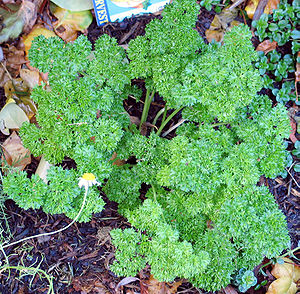
“That stuff has to go visit the devil nine times before it comes up,” grumbled Mrs. Smith. She pointed to a row of plants in her herb garden, or rather, a row that had been marked as seeded.
“What is it?” I asked, thinking it must be something awful. Henbane, hemlock, foxglove: one of those plants that can knock you dead, maybe.
“Parsley,” she said, “It’s too valuable not to plant, but it is a slow one. I planted new this year, and it’s taking it’s own sweet time.”
I had that conversation thirty years ago, one summer when I was living in the Cumberland Mountains, a spur of the Appalachians. Mrs. Smith was a herbalist who had learned her art from her grandmother, back when there were no doctors in that part of the mountains. She had strong opinions about many plants, but parsley‘s devil-connection made it instantly memorable. (I’m pretty sure she meant it only as a sort of verbal garnish — pretty sure.) Certainly I could never again see Petroselinum hortense without remembering Mrs. Smith and her garden.
It’s true that parsley is slow to germinate. It is slow, and sometimes doesn’t come up at all. However, once you plant it, it’s difficult to get rid of it, because it has a long tough tap root that goes deep into the soil. While it is officially a biennial, in the mild climate where I live, once you have it, you have it. If you don’t want it, tough. It will just keep coming back, so you might as well pick some and eat it.
Besides being pretty and green, it’s highly nutritious: high in vitamin K, vitamin C and flavonoids. It’s also a source of iron, vitamin A, and folate. Long before the Greeks began using it as a food, they used it for medicine. It lowers blood pressure and has a chemical in it called apigenin, which inhibits the growth of tumors. Eventually, though, someone discovered that it was pretty tasty, too, and the result is a panoply of Mediterranean dishes, including my favorite, tabouleh.
Which brings us back to the dinner table, and the seder plate. I know that we include parsley as karpas, greens, but it is so much more than just green! Its roots are deep. It takes nutrients from the soil, and builds life-giving, life-preserving compounds. Give it a warm patch of dirt and some water, and it will feed you generously. Some varieties are quite bitter to the taste, and some are mild. Dry it out, and it will still flavor food.
It is a stubborn little plant, not unlike a certain stiff-necked people. This Friday night, when I sit at the seder table, and dip my bit of parsley into the bowl of tears, I will remember Mrs. Smith and her aggravation with the blessing that is parsley.
Related articles
- 10 Most Popular Herb Garden Plants to Grow at Home (pjinter.wordpress.com)
- The Seder basics (guapotg.wordpress.com)
- Parsley Health Benefits (mademan.com)

One thought on “The Miracle of Parsley”
Comments are closed.